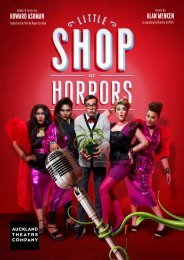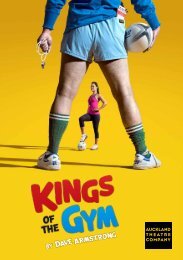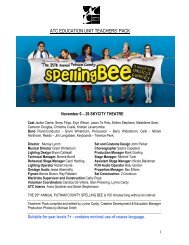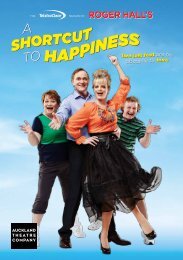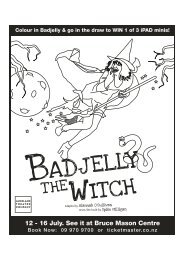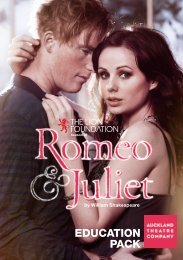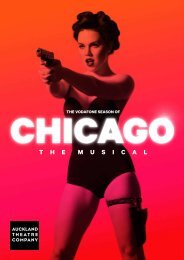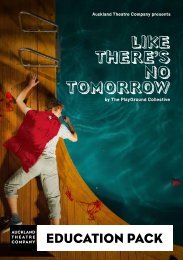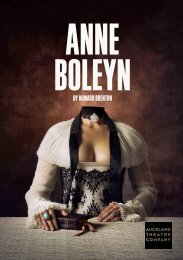You also want an ePaper? Increase the reach of your titles
YUMPU automatically turns print PDFs into web optimized ePapers that Google loves.
THE WIFE WHO SPOKE<br />
JAPANESE IN HER SLEEP,<br />
THE THIRTY-NINE STEPS,<br />
YOUNG & HUNGRY FESTIVAL<br />
09, WHO NEEDS SLEEP<br />
ANYWAY?, THE FEMALE OF<br />
THE SPECIES, DESIGN FOR<br />
LIVING, MY NAME IS GARY<br />
COOPER, THE TUTOR, THE<br />
SHAPE OF THINGS, THE<br />
TALENTED MR RIPLEY,<br />
PLAY 2 and PLAY 2.03.<br />
Other designs include ‘360’<br />
for the Wellington International<br />
Arts Festival, THE LOVER,<br />
SEXY RECESSION CABARET<br />
(TAPAC), PRIME CUTS 09<br />
(Tempo), THE CUT (Silo),<br />
HEAD (AK07 + Wellington<br />
Season), ALADDIN (AK03),<br />
MEASURE FOR MEASURE<br />
(Unitec), MINIATURES (Malia<br />
<strong>John</strong>ston), LASHINGS OF<br />
WHIPPED CREAM, KNOCK<br />
KNOCK TURN (Chris Jannides)<br />
and CORAM BOY (Unitec).<br />
His works for the theatre/<br />
dance genre included creating<br />
work for UNITEC with<br />
Shona McCullough, Michael<br />
Parmenter, Michael Hurst,<br />
Leo Gene Peters, Cathy<br />
Downes, Malia <strong>John</strong>ston,<br />
Simon Ellis, Daniel Belton,<br />
Raewyn Hill, Katie Burton<br />
and Chris Jannides.<br />
cLAIRe coWAN<br />
SoUND DeSIGNeR<br />
“The challenge in creating the<br />
perfect musical landscape for<br />
RED was in understanding<br />
Rothko’s character at any<br />
given moment he decides to<br />
put a record on, or take one<br />
off. It becomes apparent in<br />
the play that classical music<br />
is both a comfort and an<br />
inspiration for Rothko. Rothko<br />
was a Mozart and Schubert<br />
fan, I’ve chosen to include<br />
some of his favourites and<br />
expand on that with music<br />
featuring the most soulful of<br />
melodies and instruments,<br />
focusing on strings and<br />
sparser piano works.”<br />
Claire has a classical<br />
background which informs<br />
her work as a composer for<br />
film, theatre and television.<br />
Her compositions have been<br />
performed throughout<br />
New Zealand, Japan, UK,<br />
USA and Australia. She also<br />
performs as a cellist in various<br />
ensembles including the altcountry<br />
band Toad, and the<br />
Blackbird Ensemble (which<br />
she is the director).<br />
Recent credits include<br />
WAITANGI – WHAT REALLY<br />
HAPPENED (TV1), PAPER<br />
SKY and CARNIVAL OF<br />
SOULS (<strong>Auckland</strong> Festival),<br />
MOONFISHING (Prod. Heather<br />
Henson, NY), EGO (HERE Arts<br />
Centre, NY) and THE KEEPERS<br />
(Thread <strong>Theatre</strong> Co.).<br />
International Art Centre,<br />
Parnell, <strong>Auckland</strong><br />
“ART’S<br />
BUYING-<br />
AND-<br />
SeLLING<br />
mARKeT,<br />
IS INDeeD<br />
BIG<br />
BUSINeSS”<br />
<strong>By</strong> Richard Thomson<br />
Having spent over a quarter<br />
of a century involved in the<br />
New Zealand and international<br />
art market, I have witnessed<br />
many changes. In the early<br />
80s, the International Art<br />
Centre held three fine art<br />
auctions a year. In 2010 we<br />
held eight.<br />
As a fine art auctioneer,<br />
recent highlights include<br />
an oil painting by Charles<br />
Frederick Goldie (1870-1947),<br />
titled ‘Forty Winks’ a portrait<br />
of Rutene te Uamairangi,<br />
a Kingite Warrior of Taupo.<br />
On the night of the auction<br />
no less than six parties had<br />
registered serious interest in<br />
the painting. Over 15 tense<br />
minutes I took some 70 bids<br />
resulting in a final sale price of<br />
$573,000, the highest price<br />
paid for a single painting at a<br />
New Zealand auction in the<br />
(4)<br />
last 16 years. Last month<br />
we offered Les Deux Amies<br />
(The Two Friends), a modern<br />
masterpiece, by Dame Louise<br />
Henderson (1902-1994). This<br />
work received significant<br />
interest and finally sold for<br />
$102,000, double the previous<br />
auction record for the artist.<br />
In 2010 the New Zealand<br />
art market turned over<br />
approximately $20 million at<br />
auction. On a global scale<br />
this seems inconsequential<br />
when compared with the<br />
New York art market, which<br />
alone turned over $1.3 billion<br />
in the same period. But while<br />
the New Zealand art market is<br />
relatively small, it represents<br />
an important part of our<br />
national identity and heritage.<br />
On a personal level, artworks<br />
challenge us, represent a<br />
connection to our past and<br />
enhance our quality of life.<br />
In New Zealand the art<br />
market is comprised of<br />
both primary and secondary<br />
markets. In the primary<br />
market, an artist either sells<br />
directly to the public or has<br />
an arrangement with a dealer<br />
(referred to as the “enemy”<br />
by Rothko in RED). Dealers<br />
often represent a stable<br />
of contemporary artists.<br />
They maintain a mutually<br />
beneficial relationship with the<br />
artist, exhibiting their works<br />
internationally at art fairs,<br />
working with museums and<br />
managing the artist's long<br />
term career. Dealers tread a<br />
difficult path supporting the<br />
artist’s creative integrity while<br />
encouraging them to produce<br />
commercially viable work.<br />
This dichotomy is examined<br />
by <strong>John</strong> <strong>Logan</strong> within the text<br />
of RED.<br />
Once ownership of the<br />
work has shifted from the<br />
artist to the buyer, the most<br />
common avenue for resale is<br />
a specialist art auction house<br />
that operates in the secondary<br />
art market. Art auctioneers act<br />
as a conduit between vendors<br />
and buyers.<br />
Vendors sell for a variety<br />
of reasons, including tiring<br />
of an art work, cashing up,<br />
refocusing their collections<br />
or disposing of an unwanted<br />
inherited work. It is<br />
impossible to generalise<br />
about a typical profile of these<br />
vendors as they come from a<br />
cross section of society and<br />
socio-economic groups.




